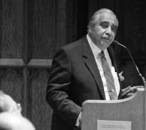Tough Questions, Provocative Answers, Lively Debate
The need to provide answers to those questions is the guiding premise of the four “Equity Matters” forums that have been conducted by TC’s Campaign for Educational Equity since the beginning of the new year. The forums—which thus far have dealt with multilingual education, measuring the achievement gap, proposed reforms to the federal No Child Left Behind Act (NCLB), and the pros and cons of class size reduction—are part of a broader initiative by The Campaign to chart the future course of equity-related education research. Each provided a fresh, balanced perspective on topics that too often are the focus of battles played out in the press among different academic and ideological camps. The audiences—in either Grace Dodge 179 or Milbank—have been large and enthusiastic; and the respondents and guests have included a
The series began in January with “Equity in the Education of Emergent Bilinguals: The Case of English Language Learners,” in which TC Professor of Bilingual Education Ofelia García criticized U.S. policy on multilingual education as marginalizing the assets that English Language Learners (ELLs) could bring to the classroom.
“Throughout the world, bilingualism is the norm,” said García, Professor of Bilingual Education and Codirector of the Center for Multiple Languages and Literacies. “But here, bilingualism in the classroom and society is the elephant in the room. In viewing non-native speakers simply as people who don’t yet speak English, we’re focusing only on the elephant’s tail.”
ELLs trail English proficient students by 39 points in reading and 36 points in math on a 500-point national scale, and more than twice as many fail their high school graduation tests, García reported.
In mid-February, the topic was measurement of the achievement gap, with former TC visiting faculty member and current Economic Policy Institute research associate Richard Rothstein as the main speaker, while Francisco Rivera-Batiz, TC Professor of Economics and Education, and John Jackson, President and CEO of the Schott Foundation for Public Education, served as respondents. Rothstein argued that the National Assessment of Educational Progress—NAEP, the benchmark federal testing program—provides a distorted picture of achievement because it focuses chiefly on fundamental academic skills and critical thinking, while ignoring areas such as the development of citizenship, appreciation of the arts, and career and occupational development. Also, because NAEP does not measure student outcomes post-high school, Rothstein contended, it fails to determine the ultimate success of pre-K–12 education.
Rothstein called for NAEP to expand its scope in 36 states in which there are high concentrations of disadvantaged students, as well as in As a model for an expanded NAEP, he also discussed an assessment tool that he is developing with two of his former students: Rebecca Jacobsen, now a researcher at , and Tamara Wilder, a TC doctoral student in politics and education. This “Report Card on Comprehensive Equity” quantifies disparities in outcomes between black and white young adults ages 17-25 across eight broad goal areas.
Rivera-Batiz said that “we cannot discuss educational equity as a black-white issue when Latinos are now the largest minority in the ” and also suffer the worst socioeconomic status. He reported that Latino students now trail other major ethnic groups in years of schooling completed, as well as in school enrollment rates after age 15, enrollment and completion of four-year college, literacy and advanced literacy, SAT scores, pre-K enrollment, and earnings from age 16 onward.
told the audience that “we aren’t facing an achievement gap as much as an opportunity-to-learn gap,” and called for establishment of a federal right to education “rather than the current system of just measuring outcomes.”
During the Q and A session that followed, Charles Rangel, longtime New York City Congressman from the 15th District and Chairman of the House’s Committee on Ways and Means, praised Rothstein’s work and suggested that public-private partnerships receive more attention as a way to fund necessary changes.
“The money is there,” he said. “We just have to put it on the line.”
Next up, in late February, was a forum on NCLB, the sweeping federal education law enacted in 2002. In his presentation, Michael A. Rebell, Executive Director of The Campaign for Educational Equity, argued that the law’s mandate that all students achieve proficiency in reading and math by 2014 should be scrapped before the rhetorical intent of NCLB “is undermined by the frustration of mounting failure.”
Drawing from Moving Every Child Ahead: From NCLB Hype to Meaningful Educational Opportunity (TC Press, 2008), the book he recently co-authored with Campaign Policy Director Jessica R. Wolff, Rebell called for Congress to establish a more achievable aim of providing “meaningful educational opportunity” for all students by 2014. Similarly, he said, each state’s “adequate yearly progress” (the performance measurement instituted by NCLB) should not be judged in terms of movement toward a fixed achievement target, but instead, by the extent to which “achievement gaps between advantaged and disadvantaged students are reduced.”
The main thrust of Rebell’s talk was that NCLB is falling short of achieving its ambitious goals because it emphasizes accountability for results while neglecting to provide the resources and supports that students need to achieve those results. A consensus definition of needed resources has emerged from the many school finance lawsuits that have been waged in states around the country during the past 20 years, said Rebell, who was the lead attorney for the plaintiff in ’s recently concluded school finance lawsuit. That definition includes sufficient ability to read and write English and sufficient knowledge of math and physical science to function in modern society; a sufficient knowledge of social studies to make informed choices about the issues of the day; sufficient intellectual tools to evaluate complex issues; and sufficient academic and vocational skills to compete for further education and in the modern job market.
Responding to Rebell were Jack Jennings, President of the Center for Education Progress, and Thomas Rogers, head of the New York State Council of Superintendents. Arlene Ackerman, a TC faculty member who recently was named Superintendent of Schools for the city of
Finally, in early April, TC Assistant Professor of Education Douglas Ready delivered an overview of research on the effectiveness of reducing class size to boost student achievement. Though enormously popular with parents and teachers, “class size reduction is not a silver bullet,” Ready said, describing himself as a “class size agnostic.”
True, there have been several major studies that show a strong cause-effect relationship between smaller classes and better student outcomes—most notably, ’s Project STAR, a study in which 6,000 kindergarten students were randomly assigned to small, medium and large classes up through third grade. By third grade, the STAR students in smaller classes were performing at significantly higher levels in math and reading, and in high school they were likelier to complete advance academic classes, take college admissions test and graduate. Black students who had been assigned to small classes were 25 percent more likely than black students in large classes take and score and higher on college admission tests.
But, Ready says, the teachers in the STAR study were nearly all highly qualified; the schools that participated in the study had volunteered to do so; and there were teacher incentives, as well. Those are conditions that cannot easily be replicated in the real world, particularly in big, urban school systems, Ready says—which is why most “quasi-experimental” studies (research that observes or recreates real-world conditions) have failed to duplicate STAR’s results. Meanwhile, while the jury is out on results for the two states that have launched full-scale class size reduction initiatives—, for example, there have been large jumps in the number of uncertified teachers, particular in schools serving disadvantaged children. In , schools and districts have been given such broad latitude for how to meet class size reduction targets that they are allowed to reduce graduation requirements and re-draw school district boundaries.
One of the principal investigators of the STAR study, Charles Achilles—Professor of Educational Leadership at Eastern Michigan University and Seton Hall University—was a respondent at Ready’s talk, and spoke up in STAR’s defense. In particular, Achilles argued, studies that minimize the benefits of class-size reduction often use improved teacher-student ratio as a proxy for reduction—and those are not the same thing, he said.
Ready, however, stuck to the view that reduced class size is, at best, a tool that can potentiate other positive factors.
“Meaningful education reform requires much deeper transformations than class size reduction alone,” Ready writes in a paper that served as the basis of his talk. Size reduction itself demands “little of students, parents, teachers, school, districts, or local and state governments. Unfortunately, reforms such as these that entail quantitative rather than qualitative change in the daily aspects of schooling rarely engender meaningful school improvements.”
The “Equity Matters” forums will resume in the fall.
_________________________________________Publications and the audio podcast of all forums can be found at:
http://www.tcequity.org/detail.asp?Id=What+We+Do&Info=Equity+in+Education+Forum+Series
Published Wednesday, Jun. 4, 2008


